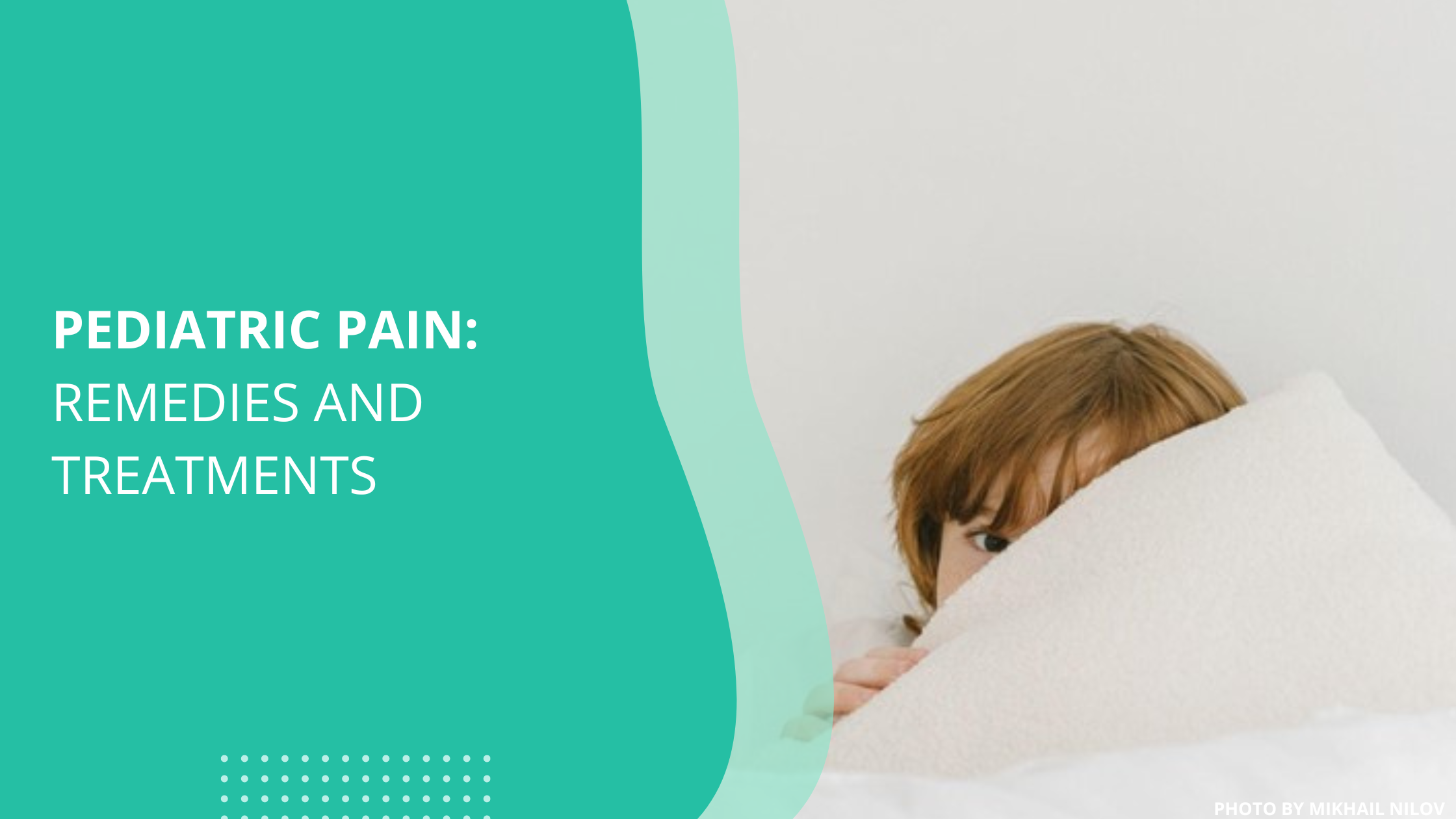
Safe Remedies and Treatments to Help Manage Your Child’s Pain
Studies have shown that 40% of adolescents and children complain of pain that occurs at least once a week. Chronic pain also affects 15% to 20% of children. When your child’s pain is left untreated, it can cause them to be more sensitive to pain as they age.
Below are safe remedies and treatments to help manage your child’s pain:
Nonprescription (Over-the-Counter) Pain Medicine
Medicine such as ibuprofen (Motrin or Advil) treats pain and fever. Since ibuprofen is also an anti-inflammatory medicine, it’s a good option when managing pain in injuries with swelling.
Ibuprofen is available in liquid form for children. Other variations include tablets and chewable tablets. When you give such medication to your child for pain, remember these things for safety:
- Check the expiration date.
- Ensure that your child is not taking other medications with ibuprofen in them. Overdosing on this drug can damage the intestines or stomach, so talk to your doctor before giving your child more of this medicine.
- Give your child a dose from the cup, syringe, and dropper that came with the product, and follow the recommended dosage.
- Don’t give your child more than four doses of ibuprofen in 24 hours.
Suppose your child spits up a dose of ibuprofen without swallowing it. Let them calm down before giving them the same dose again.
You can also use acetaminophen (Tylenol) to manage your child’s pain. It’s a nonaspirin pain reliever that soothes common aches and discomfort. Unfortunately, this drug doesn’t help with inflammation.
Acetaminophen is a safe option for children since it doesn’t cause stomach issues, unlike other medications.
Still, it’s advisable to talk to a pediatrician before giving your child any pain medication or antibiotics.
Nonpharmacological Pain Management
This type of pain management doesn’t require medicines. Instead, it uses methods to alter thinking and focus to reduce pain. Here are some examples:
- Relaxation: You can guide your child through relaxation exercises, such as stretching and deep breathing, to reduce pain.
- Imagery: Use an imaginary mental image of sound, sight, smell, feeling, and taste to shift your child’s attention away from the pain. The image should be a pleasant one.
Still, it’s necessary to talk with a medical expert regarding safe treatments when managing your child’s pain.
How to Know When Your Child Is in Pain
Some pain, like a bad cut, is easier to see and understand. However, there is pain caused by things you can’t see, such as joint pains and headaches.
Many children show they’re in pain through crying. Still, there are other ways children may react. For instance, infants and toddlers may act fussy. They may not move as much and become quieter than usual.
Other common signs of pain in children include the child exhibiting the following:
- Fever
- Heavy sweating
- Fast heartbeat and breathing
- Holds a painful part of their body
- Holds hands over ears to keep out noise
- Talks about what hurts
You know your child. If you observe, listen closely, and consider how they usually behave, you can instantly tell when something’s wrong. Unfortunately, assessing and treating your child’s pain may be difficult if they can’t describe their feelings.
Suppose your child is old enough to talk. Ask them to point to the part of their body where it hurts. You may also help them describe their discomfort by going over the list of words that express pain, such as “aching,” “itchy,” “sore,” and “burning.”
Nonverbal pain expressions, such as frowning, gasping, and wincing, can also give you clues about your child’s discomfort.
Tips to Give Your Child Medicine When They Don’t Like It
You can’t blame your child if they refuse to take medications. They may have a bad experience with a bad-tasting antibiotic, so expect some protesting from your kid when given medicine.
Remember that young children don’t understand the urgency of taking medication. So forcing them to take medicine may only lead to choking or vomiting. It’s also important to learn effective strategies for managing your child’s health.
Below are some helpful tips to give your child medicine when they don’t like it:
1. Use a Straw
Drinking through a straw can distract your child as it takes the focus away from swallowing their medicine. Using a straw can also create a solid force to flush the medication down your child’s throat.
2. Use a Plastic Medication Syringe or Dropper
Some young children become cooperative when you let them hold the syringe. If this technique works for your child, have them place the syringe in their mouth. Then all you need to do is to press down the plunger to administer the medicine.
3. Establish a Schedule
Follow a consistent medicine schedule that fits within the different set times you’ve established for other daily routines. When your child has a fixed medicine time, taking their medication won’t surprise them.
4. Ask Your Pharmacist to Recommend a Special Flavor of Your Child’s Medicine
Adding flavors such as strawberry, bubblegum, and banana is an inexpensive way to improve your child’s cooperation when taking their medicine, especially if they choose the flavor.
5. Talk With Your Child About the Importance of Taking Medicine
Your child must understand why they have to take medicine and what could happen if they don’t take it. Talk about the importance of taking medicine in a way that doesn’t make your child feel like they’re letting you down.
- Stanley Clark
Guest Article
References
- How do you assess pain in children who can’t express themselves?
https://www.sciencedaily.com/releases/2018/08/180802115645.htm
2. Pain in Children: Neglected, Unaddressed and Mismanaged
https://www.ncbi.nlm.nih.gov/pmc/articles/PMC3140088/
3. Managing pain in children
https://myhealth.alberta.ca/Alberta/Pages/managing-pain-in-children.aspx
4. How to Safely Give Ibuprofen
https://kidshealth.org/en/parents/ibuprofen.html
5. Over-the-counter pain relievers
https://medlineplus.gov/ency/article/002123.htm
6. Pain Management and Children
https://www.stanfordchildrens.org/en/topic/default?id=pain-management-and-children-90-P02740
7. How to know when a child is in pain
https://en.hesperian.org/hhg/Helping_Children_Live_with_HIV:How_to_know_when_a_child_is_in_pain
8. Medicine – Refusal to Take
https://www.seattlechildrens.org/conditions/a-z/medicine-refusal-to-take/
9. 6 Tips That Will Take the Strain Out of Giving Your Child Medication
10. Does Your Child Refuse to Take Medicine? Some Helpful Tips
11. Tips to help your child to take medicine
https://www.ouh.nhs.uk/patient-guide/leaflets/files/11990Pmedicine.pdf
Lifesaving Medications
Recent Posts
Keeping you informed and safe.
Medical Readiness: What Really Kills First
When Disaster Strikes, It’s Not Hunger or Thirst That Takes the First Lives In every disaster zone, from hurricanes in the Caribbean to war zones in Ukraine, the pattern is the same. People worry about food and water, but it’s infection that kills first. A small wound...
Exploring Dr. William Makis’ Hybrid Orthomolecular Cancer Protocol: Focus on Ivermectin and Mebendazole/Fenbendazole
Exploring Dr. William Makis’ Hybrid Orthomolecular Cancer Protocol: Focus on Ivermectin and Mebendazole/Fenbendazole *Disclaimer: This article is for educational purposes and does not constitute medical advice. Always seek professional guidance.* In the evolving...
Be Prepared for Life’s Unexpected Moments
3 Reasons EVERYONE should have emergency medications avaiable. It's all about access—access to medications and care when you need it most. And when things happen outside of your control that access can disappear.Below are 3 examples of how easily this access can be...















